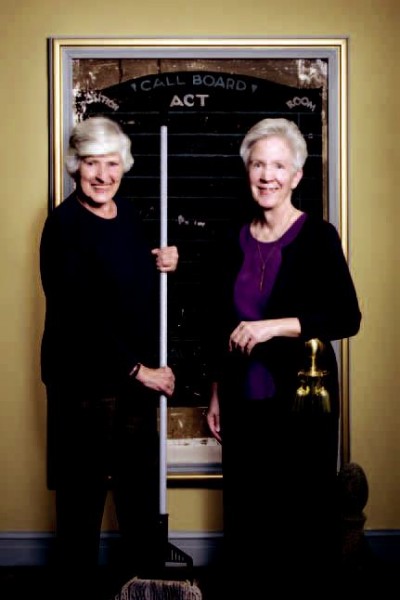The building is the story: A history of volunteerism at the Missouri Theatre Center for the Arts
December 10, 2010

Inside the restored lobby, the hush of the grand and empty building seemed to make room for my awe. Immediately, I saw what has inspired many Columbians to give hour after hour of their time to the maintenance of the Missouri Theatre. Berchek’s delight was palpable as we pass through the rooms of the theater, past the period-appropriate chandeliers and sconces.
“That one was just sitting in a crate on the stage when the Symphony Society bought the building,” Berchek said, pointing at the magnificent crystal chandelier hanging in the foyer off the entrance to the performance space.
She was referring to the Missouri Symphony Society’s 1987 purchase of the theater from the Missouri Building Company and Commonwealth Theatres, which ran the theater as a single-screen movie house.
The chandelier casts its soft light over the walls, which have been tastefully covered in rich red and gold fabric. The elegant grande dame of Ninth Street, the theater saves its best secrets not for the people passing on the street — that would be too easy — but for those who venture inside. The main performance area expands up and out into a high doming ceiling, which is painted sky blue in an effort to create an even more dramatic sense of openness.
I mentioned that the theater’s interior feels a lot like the Palais Garnier, Paris’s famed Opera and ballet house.
“I think that’s what they were after when they built the theater,” Berchek said. “That was the whole purpose of the movie palaces; they helped people be transported. You could go and partake of the fantasy. That was your home; you were a king or a queen.”
The “they” to whom Berchek referred are the Boller Brothers, Carl Heinrich and Robert Otto, the renowned Kansas City architects who designed and built the Missouri Theatre, along with nearly 100 other vaudeville houses and majestic movie palaces throughout the first half of the 20th century.
“When the Depression hit, people did go to the theater a lot,” Berchek said. “They could come to a theater like this one and feel wealthy.”
She would know; as a member of the Symphony Society’s History Committee, Berchek spent a year studying the history of theaters in Columbia, as well as the Boller Brothers’ work. Off the main lobby of the Missouri Theatre, there is a “history lounge” displaying the fruits of her research. There, visitors can look at photos of the theater’s original construction, complete with mules, as well as learn more about other Boller Brother theaters in town. The Blue Note, for instance, was formerly the Varsity, and Panera is now located in what was once the Hall Theatre.
“I always had a sentimental feeling for the theater,” she said. “Now that I’ve e-mailed back and forth with Robert Boller’s daughter in Colorado, it feels really personal. I feel a sense of responsibility. There were so many stories to tell about the Missouri Theatre, so many times it was on the brink of disaster, from the time it was built in the first place.”
In a way, that history of close calls foreshadowed the Missouri Theatre’s current financial difficulties and recent shuttering. But Berchek is far from hopeless; she is committed to keeping the space clean and well-maintained, despite the frequently dark marquee outside. At least once per week, she, Nancy Bedan or Dave Phillipe stops in to check the mail and the phones, and after big events such as weddings, they call on their legion of volunteers to come and scrub and sweep to maintain the space in its grandeur.
“All the volunteers that have come forward aren’t doing it because of me,” she said. “I think they are anxious for the chance to establish a friendship with the theater. You know people actually ask to volunteer. When I think of the entire history of the building, it occurs to me that the building is the story. There is probably no other structure in Columbia that has ensnared so many hearts.”
Christina George, current president of the Missouri Symphony Society’s board of directors, said she believes that the theater will have a bright future if it can diversify its offerings.
“We have to think far beyond classical music,” she said. “Certainly it has been done before, but the public’s perception of the building is only about classical music. We have to take the right marketing approaches, think about using it for conferences, seminars, weddings and parties. It is the jewel in Columbia’s crown. It’s one of the things that makes it nice to live here.”
Judging by how the community has rallied around the Missouri Theatre in these tough times, people are willing to do whatever is necessary to keep it open and thriving. Although Berchek debunked the myth that Bob Hope had once danced in a chorus line at the Missouri Theatre, stars ranging from Tony Bennett to Branford Marsalis have performed on the stage. There, they, too, might have forgotten they were in Columbia, Mo., content to exist inside the gilded, fantastical world created under the colored lights of the chandelier.
“It’s like discovering a huge cavern after crawling through a little tunnel,” Berchek said. “I remember thinking, ‘Does anyone know this is here?’”
More and more, the answer is yes, a fact that will be instrumental in the historic Missouri Theatre’s hoped-for comeback.


